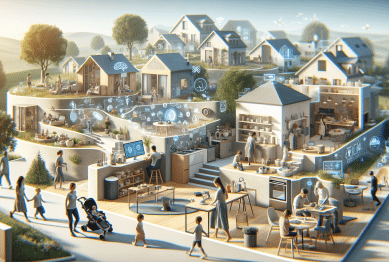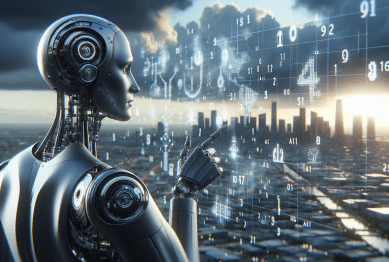Curious about how artificial intelligence is quietly transforming daily life? This article explores practical applications, surprising uses, and the impact of AI technology at home. Learn what’s changing, where you might encounter AI next, and how ordinary tasks are becoming smarter.
AI in Everyday Devices: Beyond the Hype
Artificial intelligence is no longer a futuristic concept reserved for tech enthusiasts or researchers. Instead, it’s quietly integrated into many devices found in the average household, from smart speakers to voice-activated TVs. Machine learning and natural language processing, core elements of AI, make it possible for technology to understand commands, recognize speech, and personalize experiences. These advancements have created a more seamless connection between people and devices, making technology feel less like a tool and more like an assistant.
Consider the smart thermostat, which learns temperature preferences over time and automatically adjusts the environment based on routines. By analyzing user behaviors, AI-powered devices help reduce energy consumption without sacrificing comfort. Similarly, robotic vacuum cleaners map spaces and optimize cleaning routes using artificial intelligence, making light work of household chores. This automation subtly shifts how tasks are managed, allowing more time for other activities and adding convenience to everyday routines.
Beyond convenience, these AI integrations in daily life enhance safety and security. Smart home systems use computer vision to differentiate between familiar faces and strangers at the door. AI-driven security cameras, for instance, can detect anomalies and send instant alerts when unexpected activity occurs. These features blend into the background but bring direct benefits, illustrating just how much artificial intelligence is woven into common technology at home. The result? An environment that adapts and responds intelligently to individual needs and routines.
How AI Personalizes Entertainment Choices
Streaming platforms rely heavily on artificial intelligence to suggest movies, music, or shows that fit a user’s tastes. These algorithms process intricate patterns from viewing or listening history, refining recommendations to make content discovery almost effortless. Think about how quickly a platform can queue up a playlist or identify shows that match your style—it’s all driven by machine learning. Personalization transforms how people interact with digital entertainment, increasing satisfaction and saving time.
This personalization goes further with algorithms that analyze not only viewing history but emotional responses, engagement metrics, and even pause or rewind patterns. By creating a dynamic profile, the AI continuously updates its recommendations and becomes increasingly accurate over time. Users benefit through tailored suggestions, which often introduce them to new genres, artists, or directors, expanding their media horizons without overwhelming choices.
Interactive experiences, such as voice-activated searches or responsive gaming environments, also come to life through AI. Virtual assistants can now queue up favorite playlists or find that elusive movie with a quick phrase or a simple question. This hands-free, intuitive interaction makes the entertainment experience highly accessible and fun. Artificial intelligence stands at the center, making technology feel more like a companion and less like a barrier to relaxation.
The Surprising Role of AI in Home Energy Efficiency
Many households are turning to artificial intelligence solutions to manage and cut energy use, helping them save money and support sustainability. Smart meters and home management systems use machine learning to analyze patterns in electricity or water consumption. This granular understanding allows for suggestions about ways to reduce unnecessary use, such as adjusting appliance schedules or spotting devices that might be wasting power. These insights can translate into significant savings over time.
Modern home energy systems now incorporate real-time monitoring, which can automatically react when energy prices fluctuate or when unusual spikes are detected. With AI’s predictive analytics, these smart systems anticipate demand by analyzing usage trends, the weather, or occupancy. For example, they might pre-cool a house before peak hours to avoid high utility charges or power down devices during low-use periods. This goes beyond simple automation—AI enables the home to make strategic decisions for better efficiency.
Sustainable living becomes easier with AI-powered recommendations on managing heat, air conditioning, and lighting. These smart adjustments can happen quietly in the background, allowing users to benefit from lower costs and a reduced carbon footprint without daily intervention. By learning individual preferences and optimizing systems, artificial intelligence helps create homes that are not only convenient but also environmentally responsible.
Privacy and Security Considerations With Smart Tech
The widespread adoption of AI in home devices brings up critical questions about privacy and security. While these systems are often designed with data protection in mind, it’s important to understand what information is collected and how it’s used. For instance, voice assistants and connected cameras may store audio or visuals temporarily to improve recognition abilities. Transparent privacy policies and robust security features are central to ensuring that data remains safe and confidential.
Manufacturers continue to invest in stronger encryption and multi-factor authentication to limit unauthorized access. It is also standard for users to have some control through privacy dashboards, which allow them to customize or erase stored information. These controls build trust but also require regular review, as the capabilities of AI and the types of data involved constantly evolve. Staying informed and active in managing settings is a key strategy for maintaining digital privacy in connected homes.
Even with advanced protections, no system is completely immune to threats. As smart homes become more prevalent, so too do sophisticated attempts by cyber actors. Routine updates, awareness of phishing scams, and vigilance about device permissions can dramatically reduce risks. By fostering a culture of cautious enthusiasm—embracing the benefits while attending to potential vulnerabilities—technology users make the most of AI without compromising personal security.
AI as an Accessibility Game-Changer
Artificial intelligence represents a major leap forward for home accessibility. Adaptive technologies powered by AI transform how individuals with disabilities interact with their environment. Features like real-time voice transcription, automated reading aloud, and gesture recognition can create a more inclusive space. In some homes, these tools help bridge communication gaps, offering independence and comfort to people who may otherwise need assistance.
For users with limited mobility, AI-driven home controls—like automated lighting, sensor-based doors, or voice-operated kitchen appliances—offer newfound autonomy. These systems reduce daily friction and help individuals manage their environments with greater ease. AI-powered health monitoring can even track vital signs or activity patterns, alerting caregivers to concerns without invasive procedures. This integration of artificial intelligence infuses daily life with subtle yet meaningful support.
Beyond physical capabilities, AI extends accessibility through translation, voice-activated internet searches, and context-aware notifications. These features can empower both older adults and younger residents to interact with technology in natural ways. By lowering barriers, artificial intelligence paves the way for a smarter, more welcoming home experience—one that recognizes the value of every user and adapts accordingly.
Where AI in the Home Heads Next
The evolution of artificial intelligence continues at a rapid pace, bringing speculation and excitement about the next generation of smart home innovations. Researchers are exploring how AI can create even more holistic solutions, weaving together environmental sensing, health monitoring, and entertainment into unified systems. The home of the future could be one where technology anticipates needs before they arise, making proactive adjustments for safety, comfort, and enjoyment.
Emerging trends include predictive maintenance for appliances, context-aware reminders for wellness routines, and integration of AI with other cutting-edge technologies like augmented reality. Such advances may soon allow for real-time collaboration between multiple AI agents, creating seamless transitions between work, relaxation, and personal care. The continued refining of natural language processing means that conversations with devices could soon feel as rich and nuanced as a chat with another person.
While these possibilities inspire awe, developers and policymakers are increasingly focused on balancing innovation with ethical design. As systems grow more autonomous, strong guidelines will be essential for ensuring fairness, transparency, and user control. The intersection of artificial intelligence, convenience, and responsibility forms the foundation of smart home progress, promising experiences that feel helpful, safe, and thoughtfully crafted for each resident.
References
1. National Institute of Standards and Technology. (n.d.). Artificial intelligence in the home. Retrieved from https://www.nist.gov/artificial-intelligence
2. Federal Trade Commission. (n.d.). Smart home technology and privacy. Retrieved from https://www.consumer.ftc.gov/articles/how-protect-your-privacy-smart-home-devices
3. U.S. Department of Energy. (n.d.). Using smart technology in homes. Retrieved from https://www.energy.gov/energysaver/tools/using-smart-technology-homes
4. World Health Organization. (n.d.). Assistive technology. Retrieved from https://www.who.int/news-room/fact-sheets/detail/assistive-technology
5. Brookings Institution. (n.d.). Policy framework for artificial intelligence. Retrieved from https://www.brookings.edu/research/a-policy-framework-for-artificial-intelligence
6. Harvard University. (n.d.). Connecting technologies in smart homes. Retrieved from https://sitn.hms.harvard.edu/flash/2021/connecting-technologies-in-smarthomes









